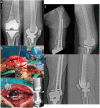Double fixation for complex distal femoral fractures
- PMID: 35446259
- PMCID: PMC9069857
- DOI: 10.1530/EOR-21-0113
Double fixation for complex distal femoral fractures
Abstract
For complex distal femoral fractures, a single lateral locking compression plate or retrograde intramedullary nail may not achieve a stable environment for fracture healing. Various types of double fixation constructs have been featured in the current literature. Double-plate construct and nail-and-plate construct are two common double fixation constructs for distal femoral fractures. Double fixation constructs have been featured in studies on comminuted distal femoral fractures, distal femoral fracture with medial bone defects, periprosthetic fractures, and distal femoral non-union. A number of case series reported a generally high union rate and satisfactory functional outcomes for double fixation of distal femoral fractures. In this review, we present the state of the art of double fixation constructs for distal femoral fractures with a focus on double-plate and plate-and-nail constructs.
Keywords: distal femoral fracture; double fixation; double plating; nail-and-plate construct.
Figures


References
-
- Jordan RW, Chahal GS, Davies M, Srinivas K. A comparison of mortality following distal femoral fractures and hip fractures in an elderly population. Advances in Orthopedic Surgery 201420141–4. (10.1155/2014/873785):873785. - DOI

